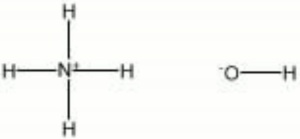Ammonium hydroxide
Description
An aqueous solution of ammonia, typically containing about 28.5% ammonia by weight. Ammonium hydroxide is a colorless, alkaline liquid with a pungent ammonia odor. Household ammonia water contains about 10% ammonia by weight. Ammonium hydroxide solutions are used as cleansers and detergents to remove vegetable stains, grease, dirt, proteins, and other accretions from clothing, glass, and ceramics. It has been used in paint strippers to soften Casein paints. Ammonia water acts as a stain for wood, producing a deep red color in Mahogany. It is also used to extract color from Grass and lichens to produce a green dye.
Synonyms and Related Terms
ammonia water; ammonia solution; aqua ammonia; ammonium hydrate; 880; liquid ammonia; ammoniaque (Fr.); hydroxyde d'ammonium (Fr.)
Risks
Inhalation and ingestion is toxic. Contact can cause irritation and burns to skin, eyes and membranes. Will evolve ammonia gas which is toxic and slightly flammable.
Can corrode some metals.
ThermoFisher: SDS
Physical and Chemical Properties
Soluble in water. pH of concentrated solution is about 12. pKa1 = 9.25
| Composition | NH4OH |
|---|---|
| CAS | 1336-21-6 |
| Melting Point | -77.7 |
| Density | 0.9333 |
| Molecular Weight | mol. wt.=35.05 |
| Boiling Point | -33.35 |
Resources and Citations
- M.R.Gilberg, N.J.Seeley, "Liquid Ammonia as a Solvent and Reagent in Conservation" Studies in Conservation, 27:38-44, 1982.
- R. J. Gettens, G.L. Stout, Painting Materials, A Short Encyclopaedia, Dover Publications, New York, 1966
- G.S.Brady, Materials Handbook, McGraw-Hill Book Co., New York, 1971 Comment: p. 57
- Richard S. Lewis, Hawley's Condensed Chemical Dictionary, Van Nostrand Reinhold, New York, 10th ed., 1993
- Van Nostrand's Scientific Encyclopedia, Douglas M. Considine (ed.), Van Nostrand Reinhold, New York, 1976
- The Merck Index, Martha Windholz (ed.), Merck Research Labs, Rahway NJ, 10th edition, 1983 Comment: entry 519
- Palmy Weigle, Ancient Dyes for Modern Weavers, Watson-Guptill Publications, New York, 1974
- Susan E. Schur, Conservation Terminology: A review of Past & Current Nomenclature of Materials, Technology and Conservation, Spring (p.34-39); Summer (p.35-38); Fall (p.25-36), 1985
- Tom Rowland, Noel Riley, A-Z Guide to Cleaning, Conserving and Repairing Antiques, Constable and Co., Ltd., London, 1981
- Michael McCann, Artist Beware, Watson-Guptill Publications, New York City, 1979
- John and Margaret Cannon, Dye Plants and Dyeing, Herbert Press, London, 1994
- Book and Paper Group, Paper Conservation Catalog, AIC, 1984, 1989
